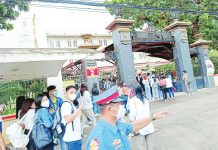
A LOFTY goal has been set by the Department of Agriculture’s Regional Office 6 (DA-6) – to cultivate hybrid rice on 100,000 hectares of farmland across Western Visayas within the year to combat disappointing yield rates and enhance the productivity of the agricultural sector.
However, the success of such a significant undertaking hinges on its practicality given the climatic adversities and infrastructural limitations that have long plagued the region.
Western Visayas, a major contributor to the country’s rice supply, faces a paradox. Despite its vast rice planting areas, the region reported a yield of only 3.4 metric tons per hectare last year, falling short of the national average. The regional executive director of DA, Dennis Arpia, emphasizes that the challenge isn’t just about quantity but also the quality and efficiency of production. The introduction of hybrid seeds, which are designed to significantly boost output per hectare, seems a promising solution to this persistent issue.
Ambitions must meet reality, however. The target to expand hybrid rice cultivation to 100,000 hectares is a steep climb from the 60,000 hectares aimed for this wet cropping season. Such expansion is not just a matter of distributing seeds but also ensuring that these lands are optimally utilized and that farmers are adequately supported in making the transition.
The feasibility of DA-6’s goal must be scrutinized against the backdrop of environmental challenges such as El Niño, which has historically affected the region’s agricultural productivity. The variable rainfall distribution can lead to significant disparities in crop success, making it crucial that the hybrid rice initiative be adaptable to less-than-ideal weather conditions.
Infrastructure also plays a critical role. Effective irrigation systems are indispensable for supporting high-yield crop varieties like hybrid rice. Yet, parts of Western Visayas grapple with inadequate irrigation infrastructure, which could undermine the potential gains from planting hybrid rice. Government investment in agricultural infrastructure, particularly in water management systems, is essential to ensure that the seeds of progress planted do not wither in parched fields.
Support for farmers transitioning to hybrid rice technology must be comprehensive. Training programs that address the specific needs of hybrid rice cultivation, from sowing to harvesting, are necessary to maximize yields and ensure that the technology’s benefits are fully realized. Furthermore, financial mechanisms such as loans or subsidies can alleviate the initial costs associated with switching to high-yield seeds, making it more accessible for smallholder farmers.
In setting such ambitious targets, DA-6 envisions high productivity and greater efficiency in the rice fields of Western Visayas. However, the success of this vision will depend on aligning these goals with realistic assessments of environmental conditions and infrastructural readiness. Only through a concerted effort that includes government support, technological adaptation, and farmer education can these lofty goals be transformed from seedlings of hope into a bountiful harvest of achievement.







